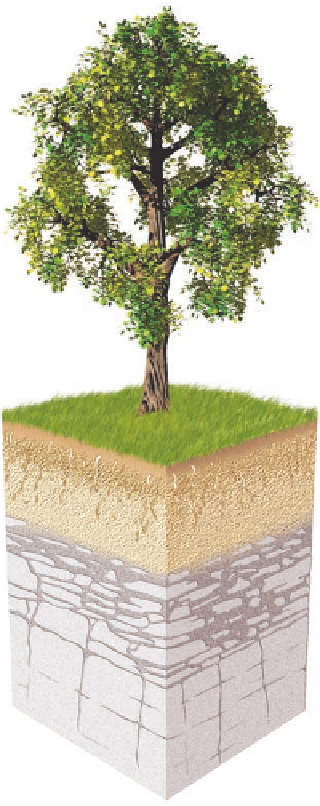Geoscience Reference
In-Depth Information
Figure 11.6 Basic soil-forming
processes.
Soils form through
the complex interaction of sev-
eral processes. Although each of
these processes usually operates
to some extent in all soils, the
rate at which any given one oper-
ates varies from place to place.
1) Soil Additions
3a) Upper Soil Depletions
• Water (by evapotranspiration)
• Carbon dioxide (from
oxidation of organic matter)
• Nitrogen (by biological and
chemical means)
• Sediments (by erosion)
• Organic matter
• Water (as precipitation,
condensation, runoff)
• Oxygen, carbon dioxide
(from atmosphere)
• Minerals (from
precipitation)
• Sediments (from wind,
water)
• Energy (from Sun)
• Energy (by longwave radiation)
3b) Lower Soil Depletions
• Water and dissolved minerals
2) Soil Translocations
• Clay, organic matter
(carried by water)
• Nutrients (circulated
by plants)
4) Soil Transformations
• Organic matter (decomposed
into humus)
• Particles made smaller
(by weathering)
• Particles made into structures
(by accretion)
• Minerals transformed
(by weathering)
• Dissolved minerals
(carried by water)
• Sediments (carried
by animals)
fall under trees. In forest settings where the leaves are not
raked, organic decomposers gradually break them down
and their remains are incorporated into the soil by simple
decay or with the aid of burrowing animals and worms.
A similar process occurs when grasses die at the end of
the growing season. Animal remains and animal excreta
that accumulate on the ground also rapidly become part of
the soil.
2.
Soil depletions
Soil depletions occur when some aspect
of the soil is lost for one reason or another (see Figure
11.6). These losses can occur both in the upper and lower
part of the soil. An example of a loss in the upper part
of the soil is when erosion by wind, water, or glaciers
removes sediment. Depletion in the upper part of the soil
also occurs when plants take up nutrient minerals or water
through evapotranspiration. Another form of depletion
takes place when carbon is lost to the atmosphere as car-
bon dioxide when organic matter is oxidized. In a similar
vein, nitrogen is lost to the atmosphere through biological
and chemical means. The loss of longwave radiation to
the atmosphere is another form of loss in the upper part
of the soil. In the lower part of the soil, losses occur when
water drains out of the soil and carries soluble minerals
with it.
3.
Translocations
Translocations refer to the vertical
movement of materials through the soil. Some movement
occurs as nutrients are cycled through plants or when ani-
mals move soil around. A significant amount of additional
movement occurs in the presence of water, which perco-
lates downward through the soil during wet conditions.
When water moves in this fashion, it dissolves miner-
als and carries them deeper within the soil, where they
KEY CONCEPTS TO REMEMBER ABOUT
SOIL PROPERTIES
1.
Soils contain organic material and a variety of minerals.
Soils also contain voids, called pore spaces, between
grains of sediment.
2.
Pore spaces contain both air and water. Following
heavy rains or periods of snowmelt, soil pore spaces
usually fill with water. This water drains within a few
days, leaving the soil at field capacity with water held
by surface tension.
3.
The soil-water budget refers to the balance between
water gained by precipitation and water lost through
evapotranspiration.
1.
Soil additions
Soil additions consist of material and
energy that are added to the soil, such as organic material,
water from precipitation, various minerals, solar radia-
tion, oxygen and carbon dioxide from the atmosphere, or
sediments deposited by wind or water. A good example of
a soil addition is the leaf litter that accumulates during the


